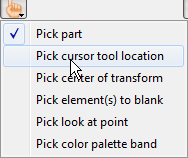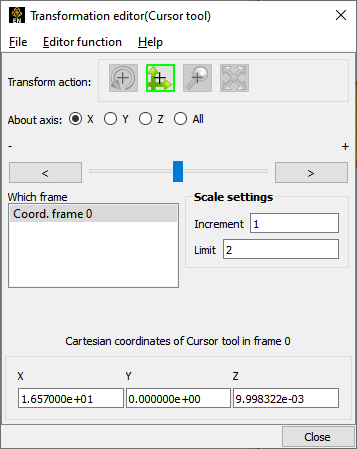In many cases, the Cursor tool will automatically turn on when performing some function that requires it. You can also turn the tool on and off manually by toggling the Cursor entry in the Tools menu or by clicking the Cursor toggle on the Tools Icon Bar.

The Cursor tool can be placed in three ways: interactively through direct manipulation with the mouse, by positioning the mouse pointer over a part and pressing P, or precisely positioned by typing coordinates into a dialog.
To position the Cursor with the mouse:

Place the mouse pointer over the center of the tool. Note that the mouse cursor will change when over the center of the cursor tool.
Click (and hold) the left mouse button.
Drag the Cursor to the desired location.
Release the mouse button.
(The / button at the bottom of screen can be used to undo/redo the tool transformation).
Cursor translation is restricted to the plane perpendicular to your line of sight. If you need to move the cursor in another plane, rotate the model such that the desired translation plane is perpendicular to your new line of sight.
Note: The Cursor may not exactly track the location of the mouse pointer.
To position the Cursor on a part with P:
Turn on the Cursor tool as specified above. Then click the button on the tool ribbon.

Select from the pop-up menu.

Place the mouse pointer over the desired location on a part in the graphics window and press the P key (or whatever mouse button you have set for the Selected Pick Action in → → ). The middle mouse button is usually defaulted to perform the pick action as well.
To set the Cursor by specifying coordinates:
Open the Transformation Editor dialog by clicking from the Tool Locations settings icon.

If the Transformation Editor is not set to Cursor Tool, set it by → .
Enter the desired coordinates into the X, Y, and Z type-ins and hit Return.

You can also move the Cursor by setting the desired axis of translation in the About Axis field and manipulating the slider bar. In this case, the values in the Scale Settings section control the sensitivity and limit of the slider action.
Note: You can also use this dialog to view (rather than set) the position of the Cursor since the X,Y,Z numeric values always update to reflect the current location. If you are positioning the Cursor interactively with the mouse, the values will update when the mouse button is released.
While Part Quick Action icons are available (indicating that one is dealing with parts), right-click on the cursor tool. You can hide the tool (make it invisible), edit it (open the Transformation Editor), or use the tool to quickly do something such as query a variable over time, or emit a particle streamline trace.


